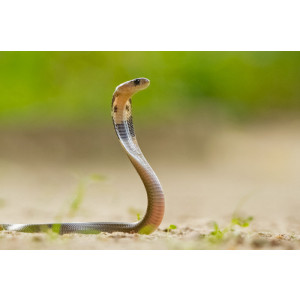Common Krait Did you see this animal?
Scientific Name : Bungarus caeruleus
Family : Elapidae
Order : Squamata
Class : Reptilia
Phylum : Chordata
Habitat : Fields,low scrub jungle and settled areas
Description : The Indian krait has a slender and elongated body that can grow up to 1.5 meters in length. It has a distinctive coloration pattern consisting of narrow black bands interspersed with broad light blue or white bands. The venom of the Indian krait is highly toxic and neurotoxic, which means it can cause paralysis and respiratory failure in its prey or victims. It is considered one of the most lethal snakes in the world. The Indian krait is primarily a nocturnal snake and is known to be quite aggressive when provoked. It is also known to be a burrowing snake, often found in underground burrows during the day. The Indian krait is found in a wide range of habitats, including farmland, forested areas, and urban areas. It is most commonly found in areas where there are rodents, its primary prey. The Indian krait feeds primarily on rodents, but it may also consume other small animals like lizards, frogs, and even other snakes. The Indian krait is oviparous, which means it lays eggs. The female lays between 6 and 14 eggs, which hatch after a period of around two months.
Distribution in Bangladesh
References:
description written by: Hajbun Tasnim Preety,Department of Zoology,University of Dhaka ; information source:wikipedia.org; photo credit:Wolfgang Wüster(www.inaturalist.org/people/Wolfgang Wüster), photo copyright: iNaturalist. more information please contact with us.
description written by: Hajbun Tasnim Preety,Department of Zoology,University of Dhaka ; information source:wikipedia.org; photo credit:Wolfgang Wüster(www.inaturalist.org/people/Wolfgang Wüster), photo copyright: iNaturalist. more information please contact with us.






































